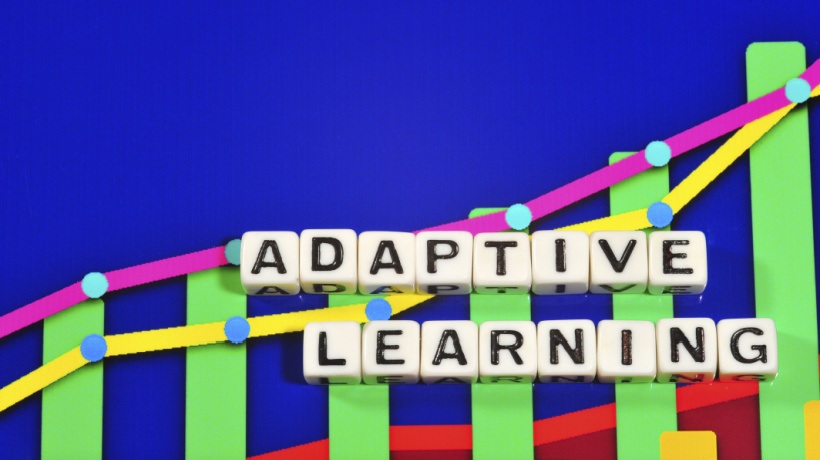Add Adaptive Learning—No Magic Required
Adaptive learning is any design that tailors a learning experience to the skills, understanding, and interests of individual learners, rather than blast "one-size-fits-all" training at everyone.
Adaptive learning promises 3 big wins:
- Greater learning and retention
- Less time spent in training
- Happier employees

Can You Create Adaptive Learning?
Some market their platform’s unique capability to provide adaptive learning by touting Artificial Intelligence (AI) or similar magic to achieve performance ends.
But for whatever reason, most can’t explain to a reasonably intelligent L&D professional how it works.
This is because it lies in their "secret sauce" algorithms, which few have mastered, fewer can communicate, and even fewer know how to leverage.
You might easily conclude that good adaptive learning demands investment in expensive technology, deep technical know-how, few hits and lots of misses, and probably all of the above.
Or that it is a silly pipe dream to even try. Which it isn’t.
Can you really do it with the knowledge and resources you have available?
Yes, You Can!
There are a variety of ways you can apply adaptive learning to your online training. To deliver it, our position (and experience) is that you need little more technological expertise than you might now have available on your team, coupled with a few useful examples, Google searches related to the tools you know, trial and error, and hopefully, this article.
Here are some things you can do, right now, to make your online training adaptive to individual learning needs, using off-the-shelf technology.

1. Add Optional Content To Training
Guide learners down a main path that provides the "skinny," and allow each to pursue topics of interest to them (that is, to take pull detours, a set of roadway signs along the main path that steer them to content that appeals to individuals in the audience), through tropes such as:
- Sidebars—additional information contained in a floating panel next to the main text
- Tool tips—popups with information that appears when things are rolled over
- "More"—buttons that allow people to get more information about something being described
Learners who have an interest in various topics or a need for additional explanation can get it, without forcing everyone to view everything. At SweetRush, we call this technique "pull detours," meaning they allow learners to take optional detours off the main path to pursue interests on their own, or not.
Like day junkets off a cruise ship to snorkel or hike up a mountain, then it’s back on board by sunset before the ship moves to the next port. It’s not for everyone, but for those who opt to sign up, it’s often a lot of fun.
Or, imagine a field trip to a zoo. Instead of marshaling 30 kids through the same exhibits, let some check out the primates, others cruise through the big cat habitat, a few visit the reptile and small mammal house, all to meet by the soft ice cream vendor at 4 to debrief.
Now, change "zoo" to "our upcoming merger" and "30 kids" to "300 managers." Let different ones go off to visit different exhibits, and all meet up afterward to debrief. And yes, ice cream.
Consider this example in an eLearning course on the topic of human rights. The audience is heterogeneous, perhaps a 70-year-old retired Argentinean judge and a 21-year-old sociology major in Hong Kong. Given the variance of legal knowledge and experience among this volunteer audience, our team decided to add a "More" button in select places to allow those who want more information to get it, while those who know it can move on.

Clicking the "Tell Me More" button adds more content to the vertically scrolling narrative (in this case, a "slideshow interaction" consisting of a sequence of image/text objects):

This allows people who need more explanation to receive it, in-line, while those who already know the concept can skip it.
2. Use Assessments That Allow Learners To Test Out Of Content They Know, Or To Fill In Content When They Need It
The idea is to add periodic assessments to an eLearning course that measure learners’ mastery of the subject matter, and then use that information to decide, algorithmically, what to do next.
There are 2 options:
- If they’re able to pass the assessment (and we’re confident it truly measures their competence), we allow them to skip a lesson or module. If they can’t pass the assessment, they have to work through it. Simple.
- If they can’t pass our assessment, we algorithmically supplement additional material to address the knowledge or skill gap we’ve uncovered, and perhaps test them again, and repeat as necessary. Address lagging learners so we can all move on. This might be done in prerequisite eLearning before a vILT class, bringing all participants to a common baseline of understanding so we don’t have a bunch of participants who are clueless. We can fill in the narrative in the prework so everyone is caught up at game time.
SweetRush calls both of these options "push detours": learners are going there whether they like it or not. Like two teenagers being asked to separate while dancing together at homecoming. Or a traffic cop telling someone to take the next exit. It’s a detour—but in these cases, an insistence, not an invitation.
Both options are actually SME dependent, not technology dependent. Technologically, they are fairly simple in most eLearning authoring environments: some elements/screens/components and a few lines of JavaScript code make content come and go as needed.
But pedagogically, it’s harder. What are the decisions we ask of learners, and what do their choices tell us? Not a technological question. It’s up to the ID team and SMEs to decide what assessment to deliver when, how to score decisions, and what to do with the information each provides. Are you confident that someone who scores 80% on this assessment can skip that lesson? Or needs augmentation?
But the effort is worth it. If we can create a reliable measure of whether learners have achieved n level of mastery, and someone passes it, what’s the point in making them work through anything that doesn’t help them get beyond n?
And if we determine a learner doesn’t know something (even if they don’t know what they don’t know), we can intervene to fill them in, without boring everyone else. We have the evidence, and we can explain to that learner why it’s necessary. This can be a great motivational tool: if learners get the assessment wrong, for valid reasons, the results should motivate them to go back and study harder and return—no harm, no foul. They will thank us, ultimately.
Here’s an example of a course that uses push detours effectively. It is an eLearning program designed to help employees understand how to navigate trade laws when doing projects in multiple countries.
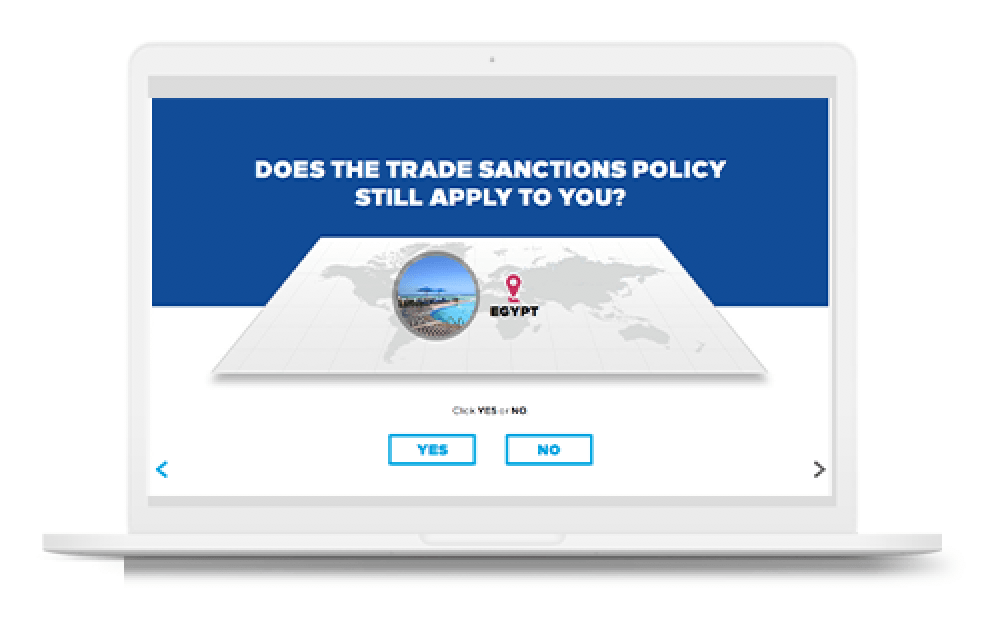
In the modules, learners are presented with seven real-world scenarios, representing situations in which their knowledge of trade sanctions would come into play:
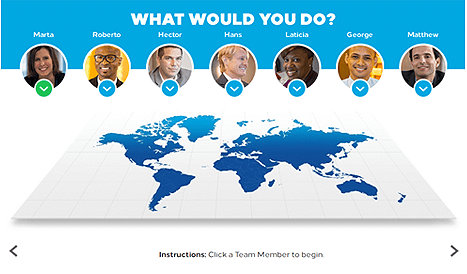
Once in a given scenario, they can read up on the situation and are then asked to make a decision:
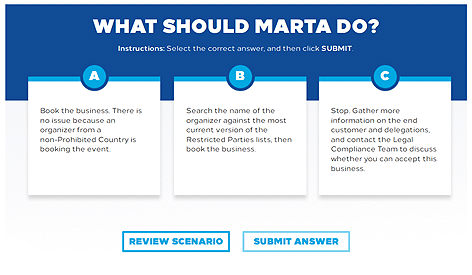
If they answer correctly, they can skip the content targeted in the scenario and move to the main menu to try the next one. If they answer incorrectly, they are given feedback and assigned content to read:

This way, learners are only provided with the information they need and don’t have to work through stuff they don’t.
3. Assign Training Based On A Learner’s Role And Responsibilities
Often, people’s need for mastering a subject area will vary by job function.
Someone in IT might need a deep understanding of cybersecurity, for example, while a contractor with limited access to a company’s technical infrastructure likely requires much less.
To address this, an eLearning course can first determine a learner’s job role (either by querying the LMS for this information, which some provide, or by asking the learner questions about role/responsibilities) and then create a custom learning path accordingly.
An example here is a training course we built about recordkeeping and data security. After a short introduction, learners are told there are a set of modules that have to be completed based on their job function, and then asked to describe their responsibilities:
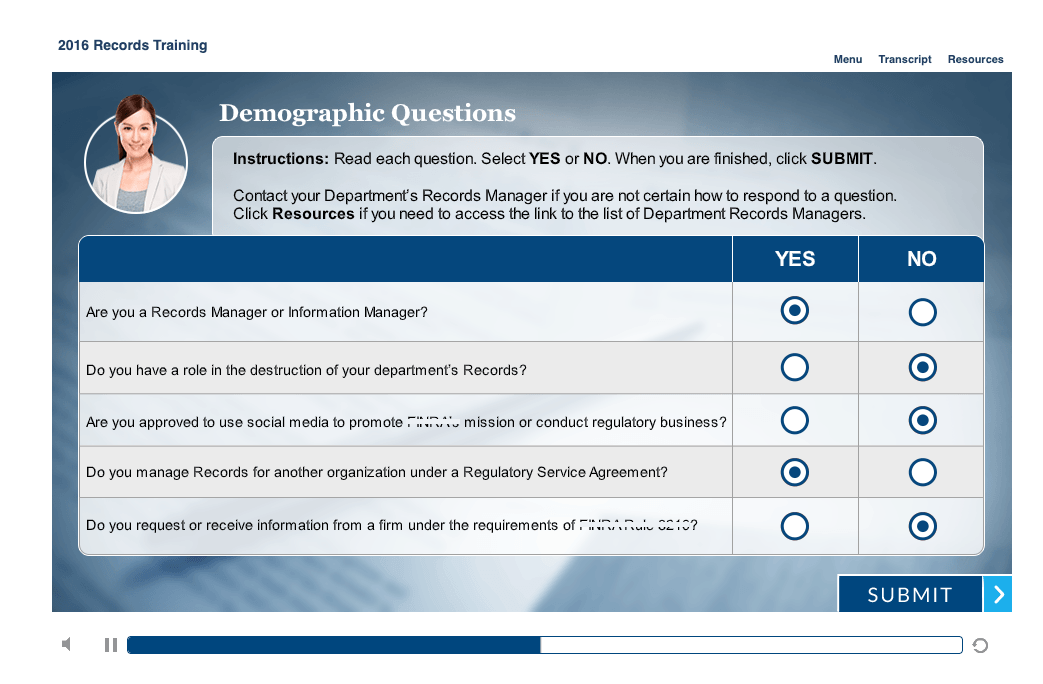
Based on their answers to the questions, specific modules are assigned to them, in this case, four modules:
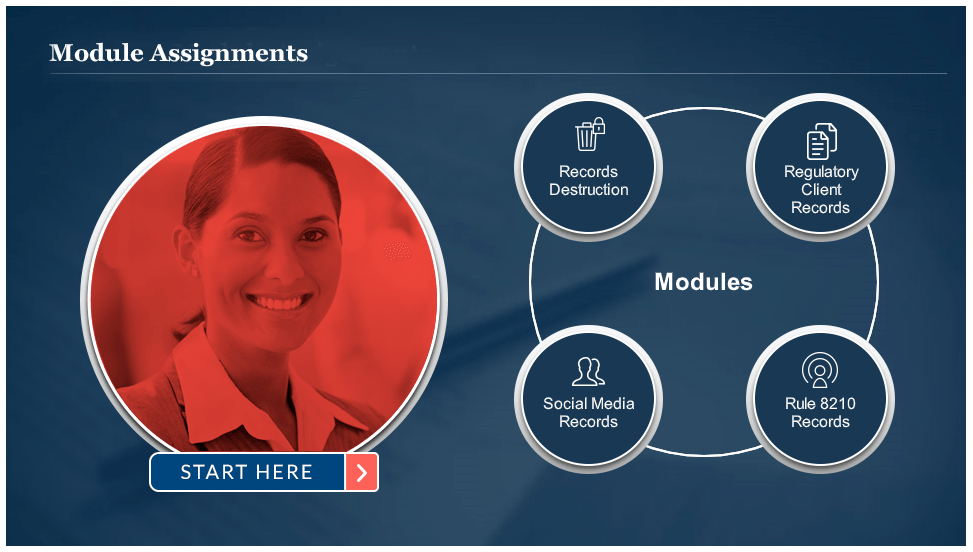
Different answers to the questions lead to different module assignments. So, learners get only the information needed to perform their role, without having to work through training that isn’t relevant to them.
4. Offer Small, Open-Ended Learning Objects That Learners Can Pick And Choose From In Order To Get What Information They Seek, Without Mandating Stuff They Don’t Want
Another approach that tailors learning to learners’ needs is to provide content as a buffet of small independent modules (for example, ones organized around various topics) and allow learners to put the modules (topics) they want on their plate. For learners with a strong model of the subject and specific gaps in their knowledge to fill, this gives them the freedom to control their training, so they get what they need most efficiently. It has a secondary benefit: it also likely makes them more willing to engage in training than if it was all forced on them. Freedom brings joy, all else being equal.
It also allows them to come and go freely, rather than having to sit for extended periods, since they decide what and when to learn and the units are compact.
An example is this new hire onboarding eLearning course. New hires as individuals may have different opinions about what they need and want to know about the company. After a brief introduction from the CEO that welcomes them to the company…
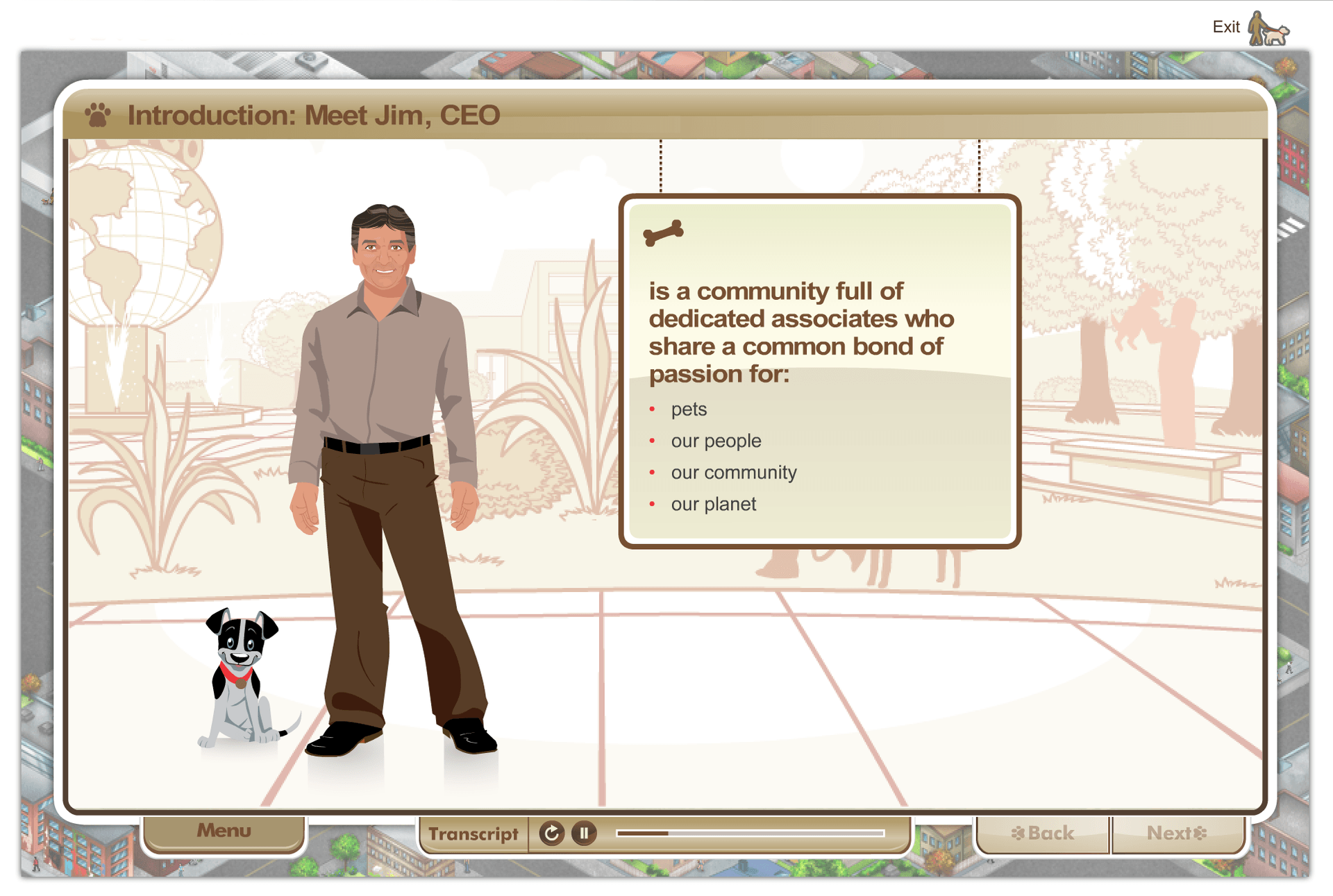
Learners are then taken to a menu of options representing different topics that interest them: they’re free to explore topics they wish to learn more about and can skip the ones of no interest to them—almost like directly asking the CEO to address the questions of interest to each participant:
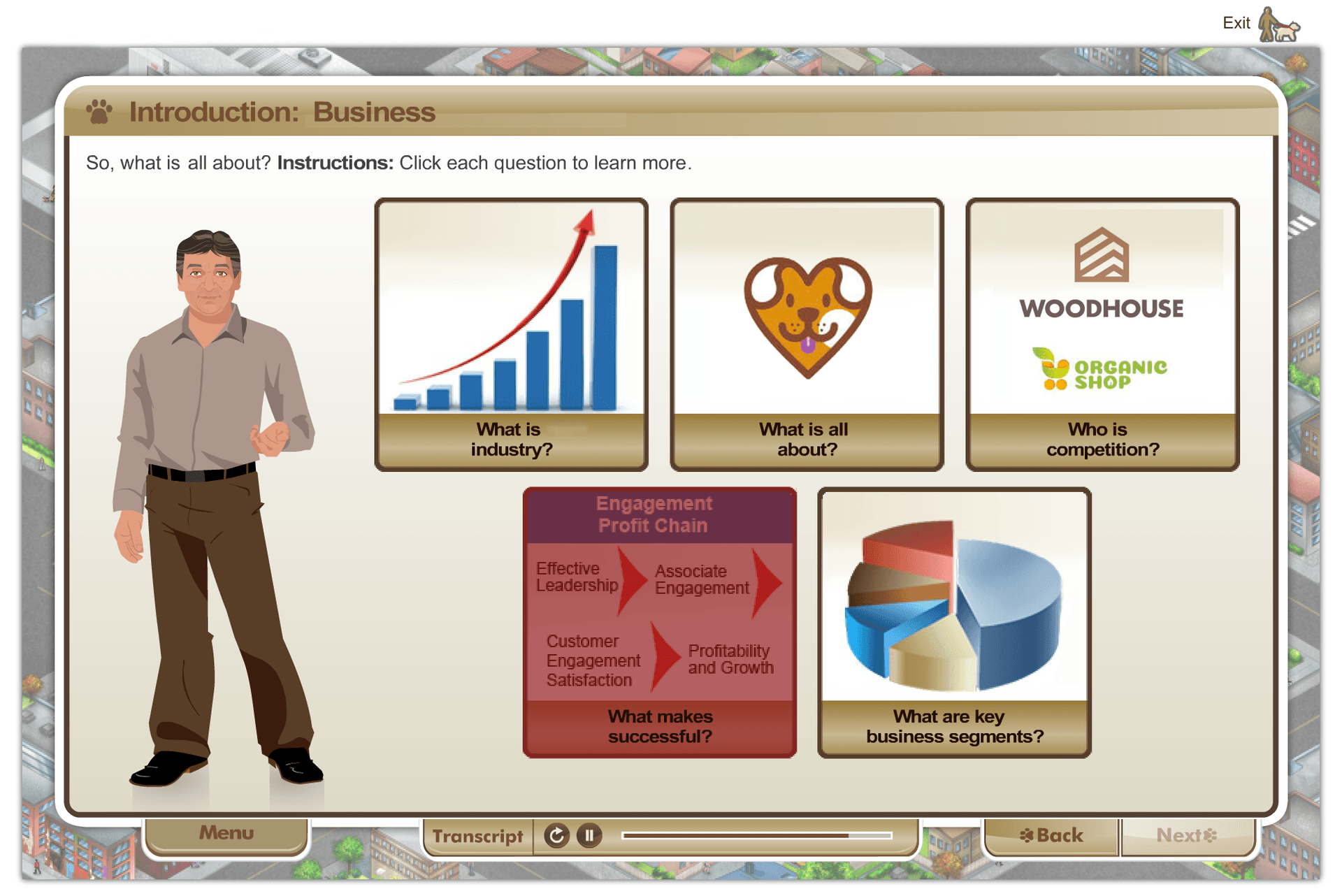
This is one way that the course provides customization: it provides learners with control over what they view, and in what order.
Further, when learners have completed the introduction, they are taken to a map of a city, in which there are hotspots representing deeper discussions about the various divisions and functional units within the company, such as a retail store, corporate headquarters, a distribution center, and so on:
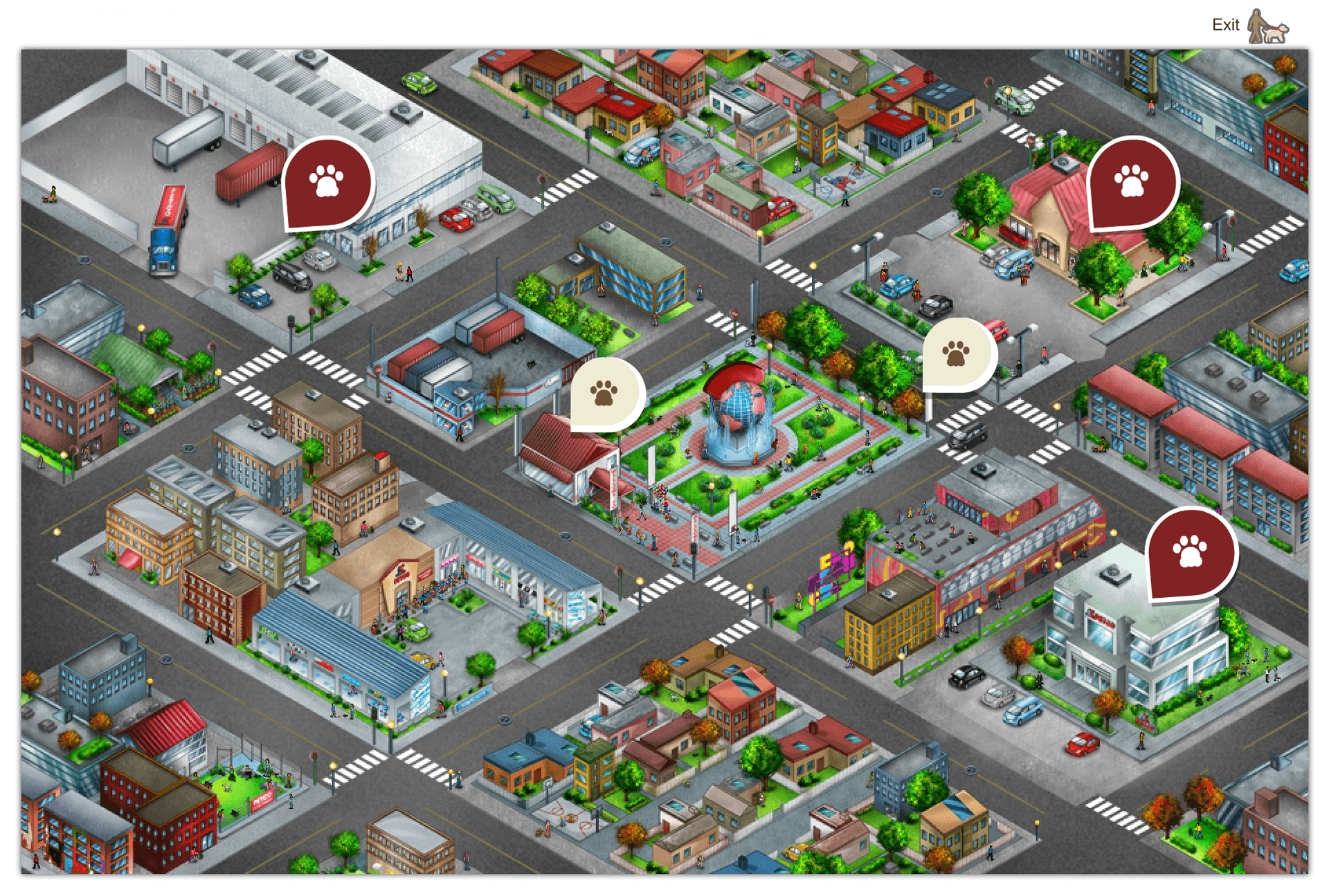
After viewing a particular topic, learners can return to the map and select other topics. They remain in control of what they experience, and when. Again, for learners with strong models, this lets them get just what they need to succeed at their new company. And, they are presumably thankful for the freedom to browse as they wish.
5. Engage Learners In A Simulation That Provides Tutoring Based On Their Decision-Making
While a simulation doesn’t always come to mind when thinking about adaptive learning, in many respects, it’s ideal for delivering training that learners need, not training they don’t. Place learners in a real-world situation in which they have to make a series of decisions. If the decisions are good, let them move on. If mistakes are made, provide feedback to address misconceptions and fill in gaps in their knowledge.
For example, we had a client that wanted to grow employee empathy toward small business owners, who face challenges far different from those faced by financial people in large corporations. The goal was to make employees more sensitive to the perspectives and needs of their small business clients.
In response, we developed a simulation that allows employees to play the role of a restaurant owner. It was important to the client that the simulation is open-ended, so there are many possible ways to operate in the simulation, and many possible outcomes. As learners make decisions, the simulation provides feedback in accordance, so they learn as they go.
When the simulation begins, employees are told they have a passion for cooking and entertaining, and a desire to open a restaurant. They’re then faced with their first decision: quit and run the business full time, or start it while keeping their current job:
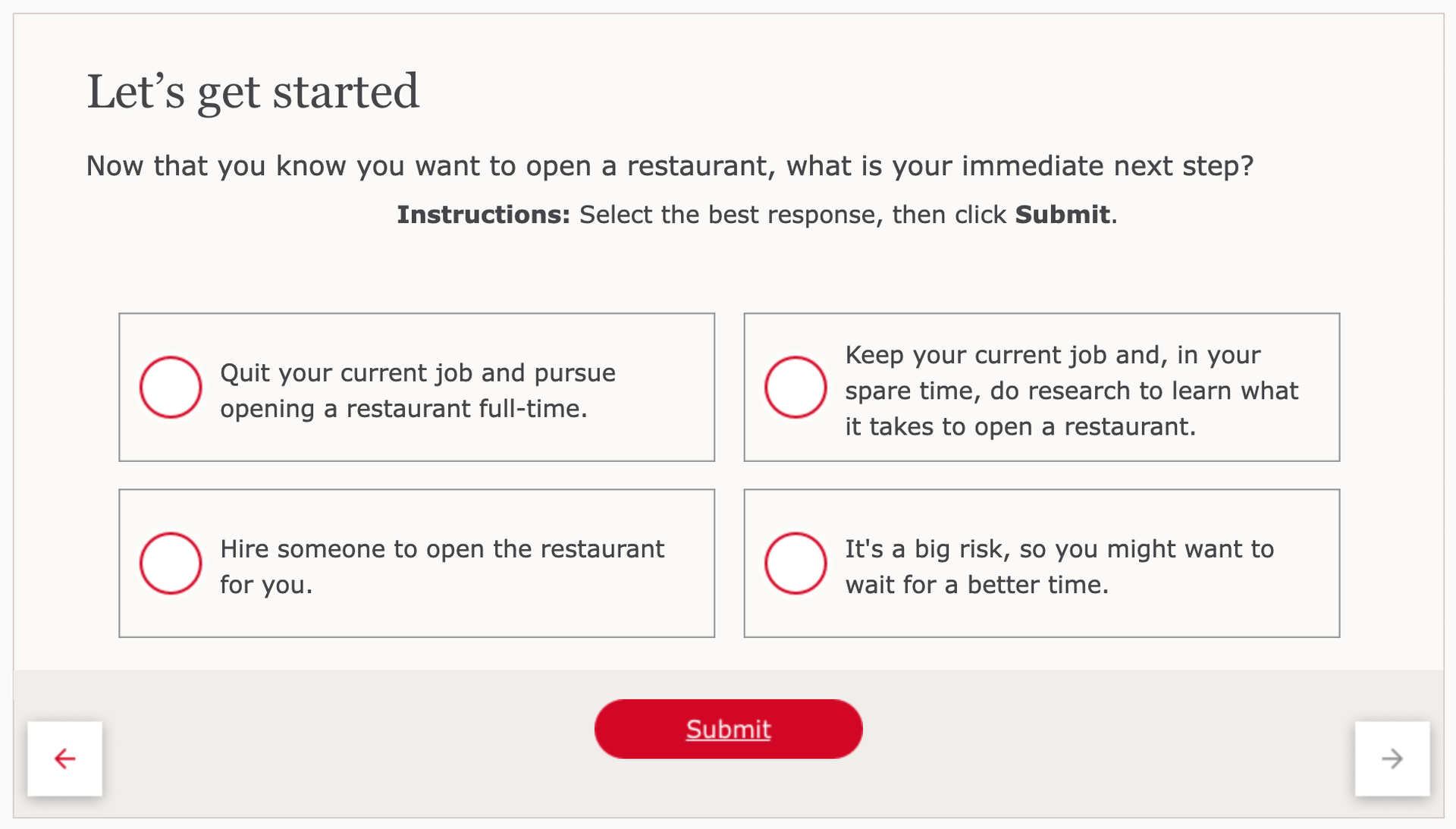
As learners progress through decisions on the restaurant (what cuisine to serve, where to locate, how to staff, which business model to pursue), the eLearning course brings up helpful information and advice. For example, when determining your business plan, a PDF is made available to enable you to find out what you need to think about when building your plan:

In this way, learners receive information relevant to the subject matter at a time and in a mental state for them to best absorb the information. Plus, it’s more engaging and impactful than to simply present learners with that information out of context.
6. Provide Chatbots Or "Expert Exchanges" So Learners Can Ask Questions And Receive Advice Targeted At Their Gaps
If the goal of adaptive learning is to tailor instruction to people’s needs, what better way than to allow them to simply tell us what they need to know, and we immediately provide it? Then, they’re not wasting a second wading through stuff they don’t care about, and we all win.
This can be achieved in 2 ways:
- Automated (fixed cost, but crude)
- Manual (more helpful, but higher cost)
Automated
As an example, think about building a chatbot using commercially available tools (for example, instabot.ai) and adding it to an eLearning course, which allows learners to ask questions (by selecting from a menu in a decision tree or by typing in questions that are processed via natural language processing, or NLP).
We’re using the decision tree approach to help an NGO deliver medical training to physical therapists (PTs) in Syria, where there is a shortage of trained medical staff: PTs know physical therapy but are often asked to provide medical consultation and advice that lies outside of their expertise because they’re the expert on the ground at the moment.
So, PTs access the course to get Just-In-Time answers to their medical questions. They don’t want to know everything about fractures: they want to know what to say to a patient who complains of lacking sleep because his fractured leg still hurts like crazy.
The "course" is a chatbot: it asks about the patient’s situation and symptoms, then provides tailored advice on what to look for, what medical care may be warranted, and so on. Below is a sample exchange from that course:

PTs get just the information they need, without having to wade through material irrelevant to it. We hypothesize that, as busy professionals, with limited time for training (most often done during downtime), but generally thankful for useful advice, they will be grateful, and lives perhaps saved. Plus, scaling the app is easier than with conventional training: adding more content is as simple as adding more questions and answers as text to the data.
Manual
An alternative solution is to let people ask questions that are answered by peers and managers rather than bots—for example, by providing a community forum where members can post questions and respond to them, perhaps as a team, or a division, or a vILT study group, or a collection of new hires, or everyone in a small organization.
But this approach has high variable costs: as demand rises, so does labor. Ten questions take 10 answers; 100 questions take 100 answers. If an answer takes two hours to build—with copy-editing and project management hours added concomitantly with what’s being discussed to whom—that’s 200 hours. With 500 or 1,000 participants, each with five to 50 questions, the amount of labor needed adds up.
However, the labor may be fully justified by the value that human intervention brings at the moment. You pick a small enough group, budget 2,000 hours (50 person-weeks) in labor to provide 1,000 answers, and any less means a savings in cost while answering every question a population has.
We use this approach on SweetRush’s intranet of 200 or so employees and contractors. In addition to providing volumes of material on how to do things, company policies and procedures, and so on, we also provide a virtual "help desk" that people can go to in order to type in a question, for which other SweetRushians can provide answers.
Once posted, this information is then available for people with similar questions to find via search.
Here is an example exchange on our community forum:
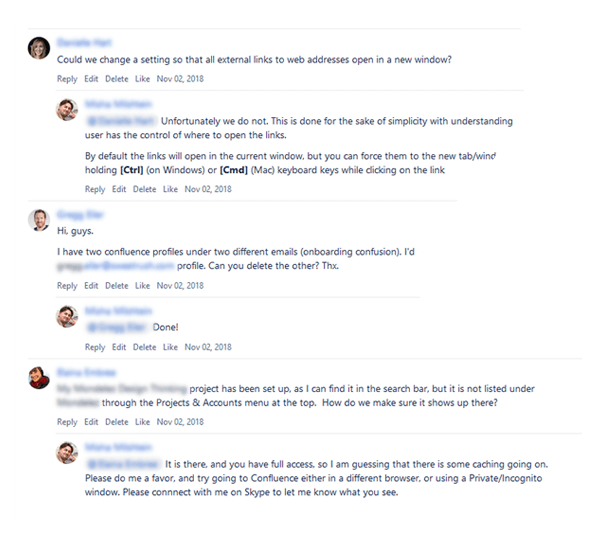
Again, learners get what they need and only what they need—adaptive learning in action, even though it’s not obvious.
So What Are You Waiting for?
These are just 6 examples of how you can add adaptive learning to your training design, without having to invest in risky technology, hire specialized (and expensive) technical expertise, or spend more time developing content than you need. All these techniques are implementable using off-the-shelf tools and technologies, a team that gets skilled, and some elbow grease.
And there are likely dozens of more variations, appropriations, and alternatives to each.
By finding the right mix for your organization, you provide learners with the freedom to receive the training they want and need, and zero minutes spent in training that brings them no value. This means deeper learning, less time spent training, and as a consequence of both, happier employees. Download the eBook Hats Off To Adaptive Learning: Tailoring Corporate Training For Each Learner, and get to discover valuable insight into adaptive learning in corporate learning.





